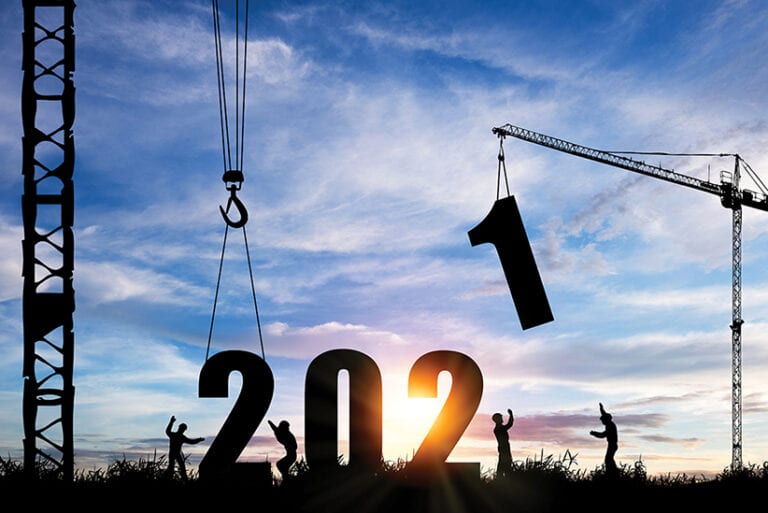If 2020 proved anything it’s that forecasting the future is far from an exact science. After all, who predicted a worldwide pandemic and the resulting economic recession? Still, business planners need some idea of what’s coming. Three industry experts offered their thoughts.
First, expectations for the overall economy.
FTR Intelligence’s Vice President of Trucking Avery Vise is cautiously optimistic. “The next year, by and large, looks to be pretty good, but there are some risks,” he said.
U.S. Xpress CEO and President Eric Fuller thinks the industry will continue progress made since the recession. “The economy seems fairly robust. I don’t see that changing in the near term,” he said.
Britton Transport President Jim Stokeland agreed. “I believe it will continue to be strong through mid-year and maybe longer,” he stated.
With one COVID-19 vaccine approved for use in the U.S. and others likely to be approved in late 2020 and early 2021, there’s a reason for optimism. But the logistics for distribution of any vaccine, including how soon it can be administered to a large enough segment of the population to allow for a return to normalcy has yet to be finalized as of press time. Vise is concerned about further lockdowns, however. “The biggest risk is in the upswell in
COVID-19 cases,” he stressed. “We don’t know what government will do.”
Capacity was a big issue to start 2020. Freight rates were expected to be stagnant or possibly deteriorate because of excess capacity caused by near-record truck sales in 2019. Indeed, sales of new Class 8 trucks in the first quarter were 24.3% behind the same period of the prior year. As the effects of the pandemic hit, second quarter sales fell 51.2% behind last year’s pace.
The market intervened. The goods side of the freight market pushed the number of available loads higher at a faster rate than drivers could return to work. The result was record-setting spot rates, with contract rates beginning to follow. Truck sales increased in the following months, ending the year with sales numbers similar to 2016 and 2017.
Unfortunately, while the economy is coming back, many of the drivers who left the industry are not. “It may be that for the first time we actually have a driver shortage,” quipped Fuller. “Our problem will be finding drivers.”
Vise provided a list of reasons drivers aren’t coming back. “We expected capacity to come back as soon as we needed it after the recession, but the fact is that it hasn’t happened.” One reason, he said, is that many have simply retired. “Whether it’s frustration with ELDs, automated transmissions, a reaction to the COVID-19 pandemic, or what, they’re hanging up the keys,” he said, adding that “there are other factors that indicate we’re facing an unprecedented driver shortage.”
One factor is fewer workers overall. “Statistics show that labor participation is a full two points below where it was before the recession,” Vise explained. “That doesn’t seem like much, but 2% of hundreds of millions of workers is a significant number.”
Another factor is a dramatic surge in the number of new carriers. While monthly registrations have only reached 4,000 a few times this century, they have been over 5,000 for five consecutive months, exceeding 7,500 in one month. Vise thinks that owner-operators who lost contracts or miles responded by obtaining their own authority and taking advantage of record-high spot rates.
Then, there are drivers and owner-operators who return to trucking, but in a different capacity. “Consumer spending has been in goods instead of services,” Vise explained. “We’ve seen reports that show we’re down about 2% on total spending, but up 8% on goods.”
Those goods must be delivered by someone. According to the Bureau of Labor Statistics, parcel/local delivery jobs have been steadily increasing for a decade and jumped nearly 8% in 2020 alone. Drivers are finding ways to earn a living and be home each night.
The COVID-19 impact on CDL schools can’t be overlooked. “Schools shut down for a long time, and even the ones that are open are at half capacity,” said Fuller.
“According to the Commercial Vehicle Training Association, 40% fewer CDLs are being issued due to school closures, and closures of testing centers,” agreed Vise.
Add to these the implementation of the Drug and Alcohol Clearinghouse. Many drivers who once responded to a positive drug test by moving to a different carrier are now leaving the industry instead. With legal marijuana now available in more states than ever before, the problem can only get worse.
Despite the obstacles, Stokeland isn’t holding back.
“We’re looking to grow aggressively in the U.S. We’re looking to net up double-digit percentages on the asset side,” he said. “Our customers need us to have the extra capacity, and we’ll seek new business, too.”
“It’s really a driver-led decision. Part of our focus is on growth, but that’s got to come with more drivers,” said Fuller.
Provided that drivers can be found, contract rates are expected to continue rising. “I still think we’ll see a 10%-15% increase in contract rates,” he added. “There has been about two years of flat while we’ve had cost increases.”
Stokeland said Britton will look at rates and expenses. “We expect to carry out specific initiatives that will improve our RPM,” he said.
With a change in direction on important issues, a new administration could impact the trucking industry in several ways. “There probably are a few issues on the radar, but the first might be the insurance minimum. It hasn’t gone up since the ’70s. It will hurt a lot of the smaller carriers,” Fuller said.
Stokeland is concerned about regulations. “I would say regulations that impact driver ability to navigate the highways and make a living each day,” he said.
Vise went in a different direction. “The bigger moves will be in environmental issues, and the biggest might be on the labor side with worker classification,” he said.
Infrastructure could be an issue, too. “Under a Biden administration, we’re more likely to get a larger, more expensive infrastructure bill,” said Fuller. That could be more bad news for capacity.
“If a new administration implements an infrastructure bill that results in massive spending, construction jobs will also put pressure on driver availability,” explained Vise.
Finally, all three weighed in on the end of the pandemic. “We hope we are in the twilight,” said Stokeland. “We will support our driving and office staff in any way possible.”
Fuller thinks the COVID-19 pandemic might have resulted in permanent changes to the way we work. “We’ve gotten comfortable with the idea of people working from their homes,” he said. “After the pandemic, we think 60%, maybe 70% of office employees will be working from home permanently.”
While the industry eagerly awaits the end of the pandemic, 2021 is sure to bring issues and surprises of its own.
Cliff Abbott is an experienced commercial vehicle driver and owner-operator who still holds a CDL in his home state of Alabama. In nearly 40 years in trucking, he’s been an instructor and trainer and has managed safety and recruiting operations for several carriers. Having never lost his love of the road, Cliff has written a book and hundreds of songs and has been writing for The Trucker for more than a decade.
















All experienced Truckers and AND O/O need to shut it down , hang up the keys ,get a local trucking job be home every night stay within 250 mile radius from your home /yard , no log book or eld required, go home every night , sleep in your own bed every night , shut down the trucking industry!
Once the trucking industry shut down ..then what how are you going to get the delivery’s done what is going to happen to the industry? We can’t survive without the trucking industry